 |
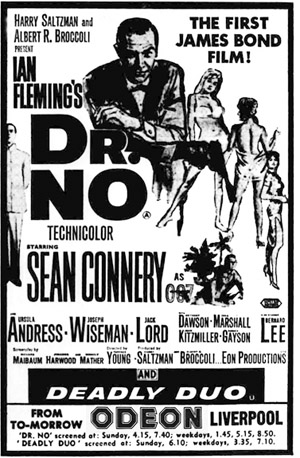 |
Founded in 1919 by
renowned silent film director D. W. Griffith; along with actors Charlie
Chaplin, Mary Pickford, and her husband Douglas Fairbanks, United
Artists operated on the principle that allowed artistes to control
their own interests, rather than being dependent upon commercial
studios. Throughout its history, United Artists functioned exclusively
as a distribution company for independent producers and was also a
financier of foreign film projects. It never operated a traditional
working studio like Metro-Goldwyn-Mayer, Universal, Columbia,
Warner Brothers, Twentieth Century Fox or Paramount.
Although United
Artists were
productive throughout the golden age of Hollywood, they were not
particularly profitable. It was perhaps the collapse of the
traditional studio system that led to United Artists becoming one of the major players in
the cinematic marketplace. Lawyers-turned-producers Arthur B. Krim and
Robert Benjamin approached Mary Pickford and Charlie Chaplin in 1950,
with a proposal to allow them to take over United Artists for ten
years. If profitable in one of the next three years, they would
then have the option to acquire half the company by the end of the ten
years and take full control. The gamble paid off, and under the
leadership of Krim and Benjamin UA turned a profit within six months,
and bought out Pickford and Chaplin to own the company outright in
1955. Acting primarily as bankers for independent productions,
among their first successes were The African Queen (1951) and
Moulin Rouge (1952), both directed by
John Huston. The
Oscar-winning Western drama High Noon (1952) starring Gary Cooper was another
substantial hit, leading to other successful collaborations with
producer/director Stanley Kramer. |
|
|
The late 1950s saw United
Artists have more critical and commercial hits with modest films
such as Marty starring Ernest Borgnine; which won the Palme d'Or at the Cannes film
festival, and Best Picture Oscar in 1955. Although not a box-office
hit at the time of its release, 12 Angry Men (1957) starring
Henry Fonda was another critical triumph, and continued UA's tradition of
collaborating with well-known actors recently freed from studio contracts,
and seeking to produce or direct their own films. First-time director Sidney Lumet
had begun his career on television, the medium which was by now having a
significant impact on box-office revenue. Burt Lancaster was another of
the actors who benefited from a relationship with United Artists, and
in 1957 starred in, and produced, the critically acclaimed Sweet Smell
Of Success directed by Alexander Mackendrick. United Artists were also
responsible for funding and distributing the early films of Robert Aldrich
and Stanley Kubrick. By 1958, United Artists were making annual profits of
$3-million, primarily because they did not have the significant physical
studio overheads which hampered the other major players in Hollywood. By
the early 1960s many mainstream studios had fallen into decline, with some
acquired by multi-corporation conglomerates. United Artists continued to
prosper, winning eleven Academy Awards, including five for Best Picture,
and adding successful relationships with Walter Mirisch (1921-2023) [and his
brothers Marvin and Harold Mirisch], who was then producing the films of writer/director Billy Wilder. In 1961, United Artists released West Side Story,
which won a record ten Academy Awards, including Best Picture.
|
 |
|
ABOVE: (Left)
The short-lived United Artists logo attached to the start of all
films distributed by the studio between June 13, 1967 and August
3, 1968 following their
acquisition by the Transamerica Corporation. (Right) The more familiar
animated Transamerica logo, variations of which were used from
1969-82. For many James Bond fans, seeing the new animated
rising ‘T’ was an integral part of the cinema-going experience in
the 1970s, and as iconic as the trademark gun barrel opening. The
ovoid colour logo was attached to US prints of You Only Live
Twice (1967); whilst all James Bond films from On Her
Majesty's Secret Service (1969) to For Your Eyes Only
(1981) opened with the blue Transamerica logo. Very much a product
of their time, the logos are generally replaced on the
commercially released DVDs, Blu-rays and digital releases of the
films with more up-to-date distributor branding. |
|
|
|
Although United Artists
has been bought, sold and merged many times over the past century, they
remained an independent studio until April 1967, when 98% of the company was
acquired by the Transamerica Corporation. Despite the re-branding, United
Artists still continued to produce critical and commercial hits including
the groundbreaking Best Picture Oscar winner In The Heat Of The Night (1967), and Midnight
Cowboy (1969) - the first ‘X’ rated film to win the Best Picture
Oscar. |
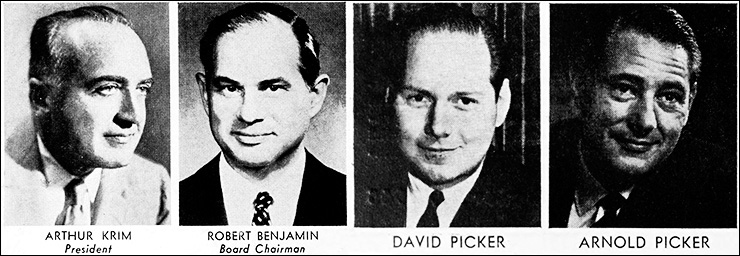 |
|
Transamerica chose Arnold Picker (1913-1989) and his nephew David
Picker (1931-2019) to run the
company until 1970, when Arthur Krim (1910-1994) and Robert Benjamin
(1909-1979) were re-instated following spectacular losses of $35-million. Although United
Artists had moved with the times, the decline in cinema attendance continued unabated until it reached an all-time low in 1970. A decade
earlier David Picker, then an upcoming executive at United
Artists, had backed UK based producers
Harry Saltzman & Albert R.
Broccoli, and signed off on the deal to fund and distribute their first
James Bond film Dr. No (1962). Always with an eye on the
international market, other successful projects backed by David Picker in
this period included the Pink Panther series starring
Peter
Sellers, which began in 1963; and Sergio Leone's Spaghetti Westerns, which
made a star of Clint Eastwood in A Fistful Of Dollars (1964),
For A Few Dollars More (1965) and The Good, The Bad And The Ugly
(1966) - all released in the US and UK in 1967-68. Several James Bond
films would later be re-issued in the UK in the 1970s on double-bills with titles from
both franchises. |
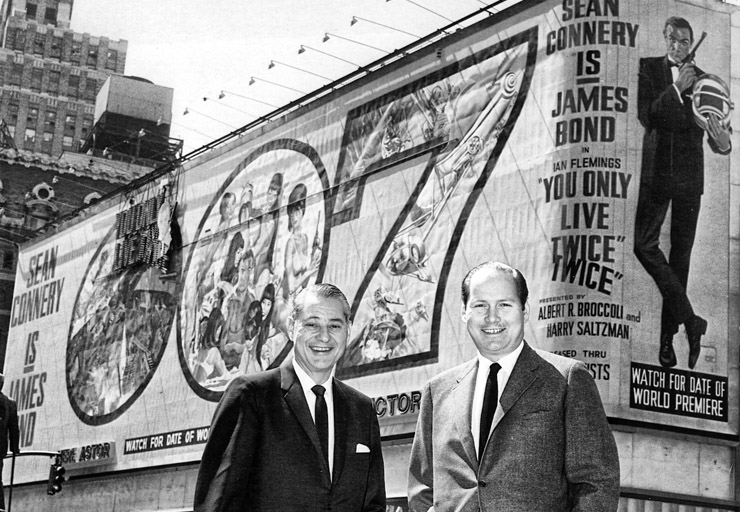 |
|
ABOVE: United
Artists executive David Picker
(right) with his uncle Arnold Picker in front of the Astor cinema on New York's Times Square.
The block-long billboard was 260-feet wide by 60-feet tall and
dominated the Broadway skyline above the Astor and Victoria
Theatres months before the opening of You Only Live Twice
(1967). The title of the film was made up of yellow neon letters
mounted with a 10-foot head of Sean Connery which travelled back
and forth over the billboard background between the theatres,
moving the full distance in 16 seconds, and then holding for 10
seconds. The iconic Frank McCarthy/Robert McGinnis artwork was
displayed within the huge ‘007’. You Only Live Twice opened
at both cinemas on June 13, 1967 - the day after its London
premiere. |
|
|
|
United Artists continued
to support new talent in the 1970s, including Milos Forman, who directed
One Flew Over The Cuckoo's Nest in 1975, which won the Best Picture
Oscar and was UA's highest-grossing film that year, taking a staggering
$163-million at the box-office. Sylvester Stallone (whose
1976 Rocky won the Best Picture Oscar), and
Woody Allen (Best Picture for Annie Hall in 1977, and UA's 3rd Best
Picture Oscar in a row) also benefited
from the support of United Artists. In 1975 as a result of personal
financial difficulties, James Bond co-producer Harry Saltzman sold 50% of
his shares in DANJAQ (the holding company responsible for the copyright
and trademarks to the characters, elements, and other material related to
James Bond on screen) to United Artists for an estimated £20-million.
Partner Albert R. Broccoli felt that Saltzman should have offered the
shares to him first, and the resulting acrimonious split brought to an end
their producing relationship, and initiated the complicated rights issues
that surround the James Bond series. DANJAQ and MGM (who merged with
Amazon in May 2021) are currently
co-owners of the rights to make and distribute James Bond films.
It was actor Topol who suggested to Albert R.
Broccoli that he should invite his former partner to the
World Premiere of For Your Eyes Only in 1981, where the
pair were reunited for the first time in several years. Saltzman attended
the event with his children Hilary (1962-2019) and Christopher
(1967-1991), and was one of his first public appearances following the
death of his wife Jacqueline in 1980. |
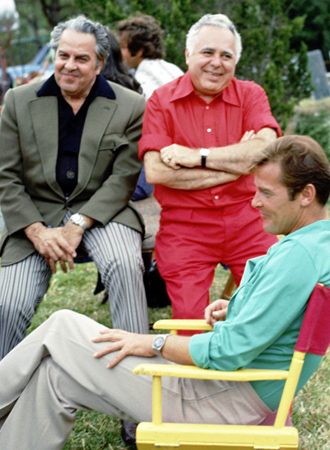 |
|
|
In 1978 Arthur Krim and Robert
Benjamin (along with several other UA executives) had walked out over a
dispute involving administrative expenses. The incoming new leadership agreed to
back Heaven's Gate, a project of director Michael Cimino, which
vastly overran its budget, ultimately costing $44-million. Cimino's epic
Western only recouped $3.5-million at the box-office, and United Artists
recorded another major loss for the year due almost entirely to the
failure of Heaven's Gate (1980). The studio was put up for sale and
acquired by Kirk Kerkorian's Tracinda Corporation, who purchased the company
in 1981. Kerkorian (1917-2015) had also acquired Metro-Goldwyn-Mayer in 1969. In
acquiring United Artists, MGM merged the company into a new corporate
entity, MGM/UA Entertainment Company. There
were many more mergers and sales of United Artists over the following three
decades, and in 2019 (100 years after it was founded) MGM re-launched the
brand as a production and distribution company.
United Artists were responsible for the US distribution of the
long-awaited 25th James Bond film
No Time To Die (2021) starring
Daniel Craig in his fifth and final outing as 007.
|
 |
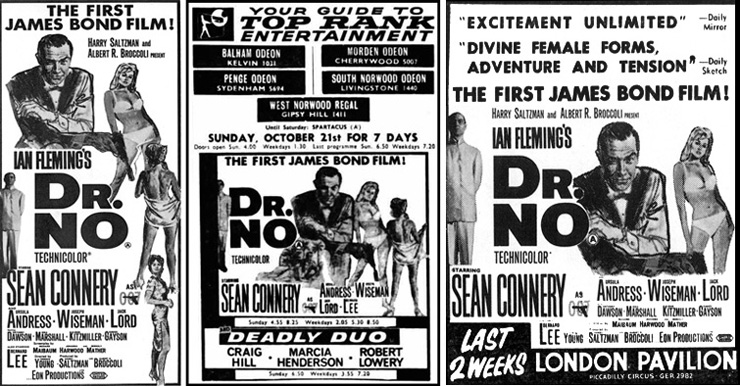 |
|
United Artists had their
London office in Wardour Street, a five-minute walk away from the London
Pavilion on Piccadilly Circus. The London Pavilion was a former music hall and
theatre built in 1859, and converted into a cinema in 1934. The London
Pavilion was
then operated by United Artists as their flagship venue to premiere films
distributed by the company in the UK until its closure in 1981. Dr. No opened at
the London Pavilion on Friday October 5, 1962,
and two days later at over 100 cinemas across the country. Since the
earliest days of cinema, new films outside the West End always opened on Sundays.
From January 27, 1983 the
opening day for new films on general release in the UK was changed to
Thursday. This coincided with an overhaul of the ratings system by the
British Board of Film Censors [British Board of Film Classification from
1984], and the introduction of new ratings certificates.
The move to Friday openings happened at the end of 1983, and
remains so to this day.
Dr. No therefore played exclusively at the London Pavilion for
only two days before going on general release. On its original release Dr. No was supported in most venues
(including the London Pavilion engagement) by
Deadly Duo (1961), a now largely-forgotten 70-minute
black & white American mystery-drama starring Craig Hill. This programme
was not a double-bill as we are now used to the term. The cinema-going experience at the time
usually consisted of a shorter second feature which played before the
advertisements, and trailers in support of the main film. |
|
The two titles on any
programme were generally unconnected, but more often than not both
films would be controlled by the same distributor, which in the
case of the James Bond films was United Artists. It was not unusual
for patrons to arrive during the middle of either film, and then
remain until the performance reached the point at which they came in.
With little control over audience behaviour (although people were
generally better behaved in public places in the 1960s & 1970s!),
there was nothing to stop ticket-holders remaining seated and watching
the main feature again! Supporting features were dropped in later
years, and generally replaced by short film subjects or documentaries and
travelogues, in order that cinemas could fit in more screenings of the
main feature each day and therefore maximise profits. |
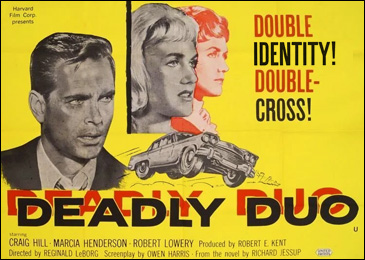 |
|
|
The first James Bond film
played at around 100 provincial cinemas up and down the country in its
opening week. Four of the London ODEON's played Dr. No from Tuesday
October 9, 1962; whilst a handful of South coast resorts including Torquay
opened the film two days later. Films playing at coastal resorts usually
changed over on a Thursday (in line with London's West End) giving holidaymakers two different choices of
programme during their week or fortnights’ seaside vacation. Dr. No
played in North East London from Sunday October 14, 1962, and in South
London cinemas a week later. With many larger suburban cinemas such as the
2,128-seat ODEON Streatham still playing the popular musical South
Pacific (1958) [which had been playing in London for an amazing
five years], the smaller venues which showed the Bond film could be more
flexible, and hold it over for a second week if required in order to cope
with public demand. Although supported by Deadly Duo in most
locations, Dr. No was also paired with other second features (also
distributed by United Artists) during its initial release. |
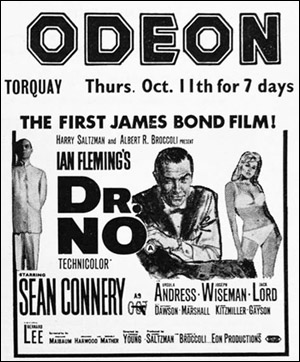 |
The ODEON Chester had
first played Dr. No for one week from Sunday October 28, 1962;
but when the film returned for a second week from Sunday December 9th
it was supported by Noose For A Gunman (1960), a 69-minute
black & white Western starring Jim Davis (1909-1981), who would
later become well-known for playing Jock Ewing in the first four
seasons of the long-running hit US TV series Dallas
(1978-1981). The same week saw Dr. No paired with The
Walking Target (1960) at the Arcadia Cinema in Colwyn Bay. Running
just 75-minutes, this crime drama had earlier supported the 1961 UK
release of I Aim At The Stars (1960) starring
Curt Jurgens as
German rocket-scientist Wernher von Braun. The 1962 US B-film
Incident In An Alley, based on a short story by Twilight Zone
creator Rod Serling, which supported Dr. No at the ODEON
Coventry for seven-days from Sunday November 11, 1962, had also been
the second feature to Billy Wilder's One, Two, Three (1961)
starring James Cagney when released in the UK earlier in 1962. All
three films were the work of Edward L. Cahn (1899-1963), an American
director of Polish ancestry. Cahn had begun his career in the cutting
rooms of Universal, eventually becoming one of the studio's top
editors, and responsible for the last-minute re-cuts of the
prestigious Oscar-winning war drama All Quiet On The Western Front
(1930). |
|
|
In early 1963 Dr. No
moved out to second-run cinemas, but made a return to some larger cities
just two months after it had originally played. After spending two weeks
at the 2,670-seat ODEON in Liverpool from Sunday October 7, 1962, Dr. No
then transferred to the 1,805-seat Rialto, and 2,100-seat Hippodrome
cinemas for a further week. On Sunday January 13, 1963 the first James
Bond film then returned to the city to play for a record-breaking four
weeks at the 620-seat Scala cinema on Liverpool's Lime Street, still
supported by Deadly Duo. Although cinema attendance in general was
still on the decline, with just under 400-million admissions in 1962, the
lowest annual figure the industry had ever recorded; the tremendous
success of Dr. No meant that the film was still playing across the
UK until May 1963, by which time it was now receiving a limited release in
the USA. Birmingham also saw Dr. No quickly return for a second
engagement in the city. After playing for two weeks at the ODEON, New
Street from Sunday October 7th, Dr. No then screened for another week
at the 1,400-seat Futurist cinema from Sunday March 10, 1963. |
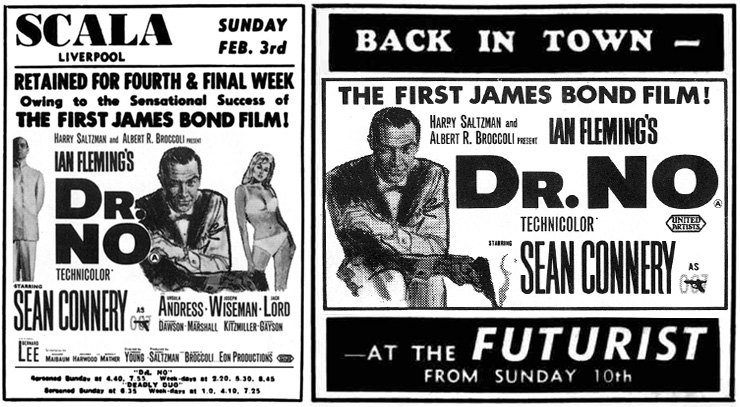 |
|
Under the conditions of
the Sunday Entertainments Act (1932) opening time was
widely restricted to 4.30pm in England, and a percentage of individual cinema profits
for that day were paid to the Cinematograph Fund (which ultimately became
the British Film Institute). This meant that the first day a new film
opened it usually only played for one or two performances. Sunday opening was
not usually allowed in Scotland or Ireland, so films normally played from Monday to
Saturday. Dr. No therefore played at the 2,784-seat ODEON Renfield Street, Glasgow for two weeks from Monday October 8, 1962,
then transferring to the 4,368-seat Green's Playhouse (also on Renfield Street) for another six days from
Monday October 22, 1962. Opened in 1927, Green's Playhouse was believed to
be the largest cinema ever built in Europe. It stopped showing films in
June 1973, and was later renamed the Apollo Theatre, becoming Glasgow's
leading music venue until its closure on June 16, 1985. |
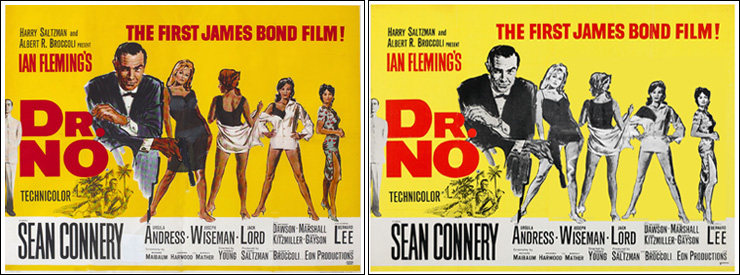 |
|
When Dr. No first played in
the Republic of Ireland in October 1962, the quad-crown poster provided to cinemas by the
National Screen Service was censored to cover much of the exposed female flesh
depicted in Mitchell Hooks’ artwork. This was achieved by using a thick
marker pen (or sometimes poster paint) over the original art. The
Ursula Andress figure often ended up with a long dress covering her bikini, and
the other girls were similarly altered. The Irish Film Censor's Office also objected to
the depiction of firearms on posters, so the additional credit next to
Sean Connery's name stating ‘as 007’ was also removed as it contained a
small graphic of a gun. Note also in the poster above how the addition of
a dress to the Ursula Andress figure also makes Bond's silenced gun less
prominent. Similar censorship was also applied to late 1960s re-issue
posters, although less female flesh has been covered up on the example
above. As this was all
done by hand when the posters arrived in Ireland no two were identical, and
consequently these are some of the hardest to find nowadays. The practice
continued well into the 1970s and numerous James Bond and other film posters
were ‘doctored’ in this way. Dr. No first played at the large
2,900-seat Savoy cinema in Dublin for two weeks commencing Friday October
12, 1962. Opened in 1929, the Savoy is the oldest operational cinema in
Ireland, and became the first-run venue for all subsequent James Bond
films. Converted to two screens in 1969; with a third added in 1975, the
cinema currently boasts 13 screens, although the overall seating capacity
is now much reduced. |
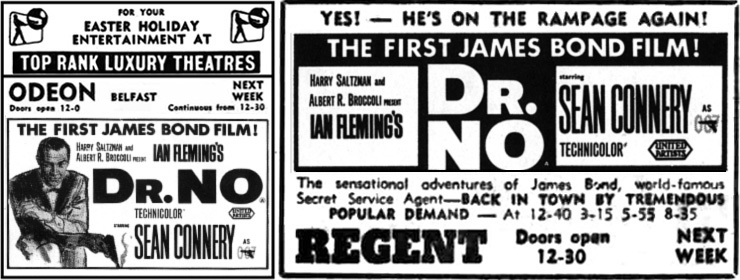 |
|
Dr. No didn't
reach Northern Ireland until Easter of 1963, when it finally opened at the
1,800-seat ODEON in Belfast on Monday April 15th. The film played for two
weeks and then returned by popular demand to play another two weeks at the
smaller 850-seat Regent cinema. On Monday May 25, 1963 Dr. No
then played at the 1,400-seat Stadium cinema for six days, and also
concurrently at the Capitol cinema and Lisburn Picture House. After a
short break Dr. No returned to Northern Ireland once more to play
for six days from Monday June 3, 1963 at the 2,250-seat Tonic cinema in Bangor, and concurrently at
the 1,380-seat Broadway cinema on the Fall's Road in Belfast. The first
James Bond film proved very popular with cinema audiences in Northern
Ireland, despite them having to wait six months to see it. Subsequent
films in the series would often play in Northern Ireland long before they
went on general release on the UK mainland. |
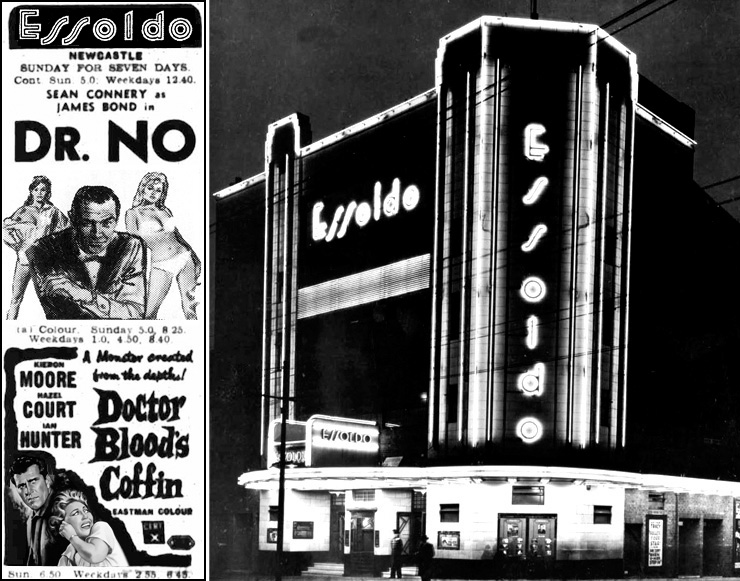 |
|
ABOVE: (left)
A Newspaper advertisement announcing the return of Dr. No
to Newcastle on Sunday June 9, 1963 at the Essoldo Cinema,
Westgate Road. Built in 1938 as the flagship of the Essoldo
circuit, the 2,200-seat cinema was owned by Sol Sheckman
(1893-1963) a Tyneside entrepreneur whose empire rivalled that
of his main competitor The Rank Organisation, who operated the
ODEON and Gaumont cinemas. Many have wondered where the name ‘Essoldo’
came from – the ES came from Sheckman's wife Esther;
SOL came from himself; and DO from his daughter
Dorothy. Many of the Essoldo cinemas such as the Newcastle,
Westgate (right) rivalled the ODEON style with their art-deco
neon gaudiness. The cinema became part of the ABC chain in
1974, then Cannon who closed it in 1990. The building was
demolished in 1991. |
|
|
|
Although Dr. No
had played at the ODEON Newcastle for two weeks from Sunday October 7,
1962, the film returned to play another week at the 1,600-seat Pavilion
Cinema from Sunday October 21, 1962. This cinema was operated by the Rank
Organisation and generally reserved for ‘Roadshow’ presentations in the North-East due
to its 70mm capabilities and stereo sound equipment. Dr. No
returned to the city again and played at another large ‘Roadshow’ cinema, the
2,200-seat Essoldo Newcastle. Opening on Sunday June 9, 1963 this time supported by another United
Artists film Doctor Blood's Coffin (1961). Although Bond films were
double-billed in later years with other United Artists films from
different franchises (including Clint Eastwood westerns and a Pink Panther film),
Doctor Blood's Coffin was an unusual choice to say the least. This
may even have been a joke on the part of the booking manager to get two ‘Doctors’ on the same
bill! As the supporting film was awarded an ‘X’ certificate by the
British Board of Film Censors, this meant that at the time audience members needed to
be at least 16 years old to be admitted. The 92-minute sub-Hammer zombie
horror film was directed by Canadian Sidney J. Furie, whose most notable
film would be The Ipcress File (1965), starring Michael Caine as
Harry Palmer, and produced by Harry Saltzman. |
|
 |
 |
 |
|







